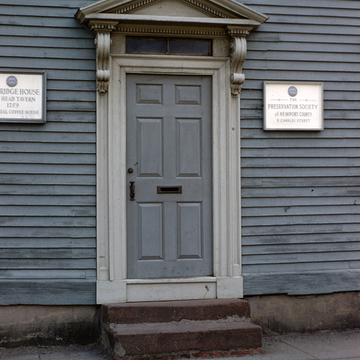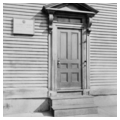You are here
Pitt's Head Tavern (Ebenezer Flagg House)
Another big gambrel-roofed house, this one is twice removed from its original site on the northwest corner of Washington Square at Charles Street in the center of town. It is another example of an earlier house (owned by Jonathan Chace) embedded in a later eighteenth-century remodeling and enlargement. The massively sculptural chimney (rebuilt), its framing, and the flat S-sawn balustered stairs folded into three runs in front of it date from c. 1725. The expansion of the house into a full five-bay format occurred in the mid-eighteenth century, shortly after Ebenezer Flagg obtained it, apparently as a wedding present from Henry Collins, who purchased it in 1747, the year after Flagg's marriage to Collins's niece, Mary. In addition to heading one of the largest shipping and merchant firms in Newport (with a vessel for every letter of the alphabet, as one contemporary put it) the two men were leaders in the cultural and intellectual life of the city. At his death Collins owned a collection of seventeen paintings, including four portraits by Robert Feke and one by John Smibert. Both he and Flagg were founding members of Redwood Library. The bankruptcy of the firm of Collins, Flagg and Engs in the early 1760s was followed shortly by the death of both of its principal partners. The house was sold to Robert Lillibridge in 1765 and thereupon began a more boisterous life as one of Newport's celebrated coffeehouses and taverns under the sign of Pitt's Head. At the time, the Great Commoner's sponsorship in Parliament of a liberal colonial policy created special enthusiasm for him—especially in Newport, which was chafing under the very British maritime regulations which had been part of the reason for the Collins-Flagg bankruptcy.
The slightly skewed symmetry of the window placement doubtless reflects compromises in updating an old building on what was originally a tight site on Washington Square. The correctness of the door frame with its pediment on scrolled brackets and both the proportions and moldings of the alternating triangular and segmental pediments of the attic dormers indicate Peter Harrison's sophisticated influence on classical design by the mid-eighteenth century—appropriate for a client who was in the Redwood circle and alert to cultural change.
Writing Credits
If SAH Archipedia has been useful to you, please consider supporting it.
SAH Archipedia tells the story of the United States through its buildings, landscapes, and cities. This freely available resource empowers the public with authoritative knowledge that deepens their understanding and appreciation of the built environment. But the Society of Architectural Historians, which created SAH Archipedia with University of Virginia Press, needs your support to maintain the high-caliber research, writing, photography, cartography, editing, design, and programming that make SAH Archipedia a trusted online resource available to all who value the history of place, heritage tourism, and learning.













